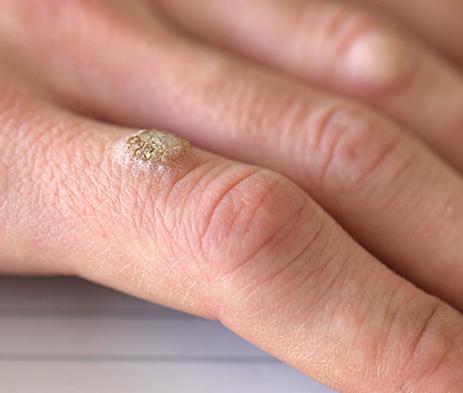Warts and Verrucas
Struggling to get rid of stubborn warts or verrucas?
While very common and unusually harmless, warts and verrucas can sometimes be a source of discomfort and embarrassment too. Get in touch today and find out how the experienced team at The Dermatology Clinic can help.

Over-the-counter treatments aren’t always effective for tricky warts and verrucas that seem determined to hang around or have started to spread. Find more information below on warts and verrucas, and the treatments available at The Dermatology Clinic.
About warts and verrucas
Warts and verrucas are caused by the same type of viral infection on the skin, but they affect different body parts.
Warts
Warts most commonly have a rough surface and are firm to the touch. They are round, raised bumps that lie against the skin and usually occur on the hands and feet, but are sometimes found on other parts of the body as well. Warts can develop in groups across the body and they are contagious, which is why many people come to The Dermatology Clinic to have them removed.
Verrucas
Often picked up at swimming pools, verrucae form on the soles of the feet. They are a type of wart, but appear flatter because they have been pressed into the foot by the pressure and weight put onto them. Verrucae can be painful and are very contagious, so if you have one it’s important to get treatment as soon as possible.
Treatment for warts and verrucas
Eventually, warts and verrucas will usually resolve on their own but this can take a long time, sometimes several years. Our team understands that warts can be an embarrassing problem and can sometimes hinder daily activities, particularly if they occur on the fingers or feet. That is why The Dermatology Clinic offers treatment to speed up the time taken for these lesions to resolve.
Treatment will depend on the nature of your wart or verruca and options include:
Cryotherapy
Cryotherapy works by essentially freezing off the wart or verruca and is one of our most popular removal treatments. This is because the process is very simple and has a high success rate. Cold liquid nitrogen is applied to the area, freezing the cells within the lesion.
After treatment, a blister will form where the lesion used to be, which will then form a scab. The scab will fall off in around 7-10 days and usually, more than one treatment is required. The treatment of verrucae with cryotherapy can leave the feet sore for a few days afterwards, but this should subside as the site heals.
This is a very effective method for removing warts and verrucae, but though it is simple, cryotherapy is very precise. For that reason, it’s important that it is only carried out by trained, professional dermatologists at The Dermatology Clinic. Dr Glass has more than a decade of experience in dermatological procedures and is qualified to ensure you leave the clinic feeling satisfied with your skin.
Curettage and cautery
This procedure is similar to excision, but it uses a spoon-like instrument called a curette to essentially scrape off the wart or verrucae. Our professionals will then seal the wound with heat (this is known as cauterisation). Again, for your comfort, we will apply local anaesthetic before treatment and the wound should be gone within two weeks, leaving you to get on with your daily life without having to worry about your wart or verruca getting in the way.




